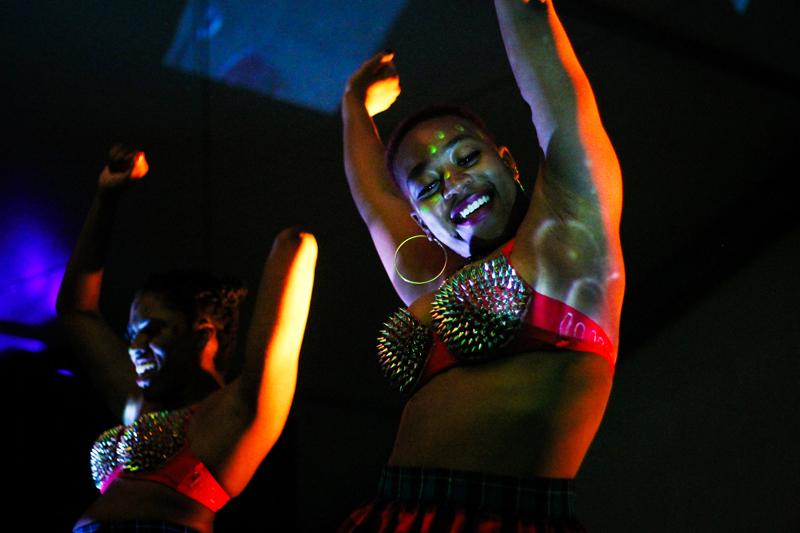In Spite of Controversy, Massive Crowd Gathers for Toxicity
College sophomore Sophie Umazi Mvurya (right) moves to the music at Toxicity last Friday night. The wasteland-themed event, hosted by Solarity, featured student DJs and musicians and culminated in a “Silent Disco.” Attendees were issued wireless headphones through which they could choose from two music channels.
May 9, 2014
Solarity’s latest event, Toxicity, generated nearly as much energy as a nuclear power plant. Despite the controversy surrounding the event concerning its name, hundreds of students flocked to Wilder Bowl last Friday night to see student artwork and dance the night away. The display seemed a far cry from the advertised “wasteland,” with only a few decorated trashcans conveying the nuclear wasteland theme. With blinking lights hung from the trees and the Solarity members’ glowing costumes, the event conveyed the atmosphere of the colorful, inviting dance “playground” we’ve seen in other Solarity shows.
Having had to grapple with new limitations issued by the administration since last spring’s Solarity event, Awaken the Wild, Solarity’s team of 25 active members focused on representing and accommodating as much of Oberlin’s diverse student body as possible. Artwork and performances by various student organizations have become as much a part of the program as dancing and having fun. Thus, this year’s spring edition included performances by the student dance group Koreo, fashion creations by College sophomore Sophie Umazi Mvurya, and a performance by the rapper Van ’Go. Whilst the dance floor itself was only open to ticket holders, everyone walking through Wilder Bowl on Friday night had a chance to admire video installations and other artwork on the walls of Mudd library.
Solarity, a student-run group that strives to “unify campus through large-scale music and dance productions as platforms for artistic expression,” has taken on a difficult challenge. It has to fulfill two sets of expectations, one artistic and one entertainment. However, not much of the “beautiful extraterrestrial environment, with slime, fog and bubbles” promised in the group’s advertisement was present; if it was, it was not visualized well enough in the main decorations surrounding the stage and dance floor. There also was not as coherent a dialogue between the events on stage and the presented visual art as many had hoped.
Both organizers and the audience seemed to be much more concerned with the climax of the night, the Silent Disco, which was set to launch at midnight and would allow the dance party to go on until 1:30 a.m. without violating a noise ordinance. In exchange for their college IDs, students received a pair of wireless headphones with two different audio channels. From 12 to 12:45 a.m., DJs Huang and Daogwen played strikingly different sets. While one played a more hip-hop and beat-driven set, the other gave the EDM, rave-like set many students were eager to dance to. From 12:45 to 1:30 a.m., DJs Rec Specs and Huh Huh played to a slightly smaller crowd. For those that had a working set of headphones, the Silent Disco was an exciting, unique experience. For those that got caught waiting in line or who received non-functional headphones, however, the event proved disappointing. While the listening experience was variable, the visualexperience was most certainly entertaining, as people moved to different rhythms despite being closely packed and exploded in cheers and shouts at different times. Close physical interactions were made particularly funny to watch as students fumbled around each other’s headsets.
The headphones proved to be the most significant problem and poorly planned part of the event. Starting at around 12:45 a.m., long lines formed around the distributingtables as students attempted to return the headphones and collect their IDs. Some students complained about standing in line for about an hour, while other students merely cut the line and danced the night away.
Although not all were pleased with the Silent Disco, all agreed that Solarity made an extreme effort to provide a fresh party experience that the Oberlin campus had never seen before.



















